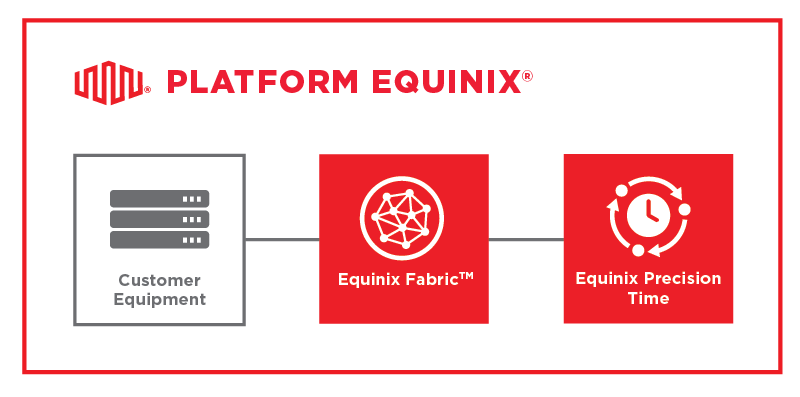Technical Concepts
Equinix Precision Time receives accurate time from GNSS sources, then uses industry-standard time protocols to distribute that time across the network.
The Precision Time Time Source
Equinix Precision Time sources precise time from the Global Navigation Satellite System (GNSS), including Global Positioning System (GPS) using GNSS receivers.
Precision Time infrastructure uses redundant GNSS receivers capable of receiving GPS signal accurately to deliver precise time. In addition, the GNSS receivers are equipped with Rubidium atomic clocks to holdover timing accuracy if for any reason connectivity to the GPS signal is lost
The GNSS receiver and antennas used in the Precision Time infrastructure have the capability to receive signals from multiple GNSS constellations, including GPS L1, GLONASS L1, BeiDou B1, Galileo E1, and QZSS L1. Together, these time sources provide multiple levels of redundancy.
The GNSS-enabled grandmaster clocks use Rubidium oscillators that provide accuracy up to the sub-microsecond when locked with the GNSS (GPS) source. Even with a loss of connectivity to the source, the service can maintain up to sub-microsecond level of accuracy.
Unfortunately, GNSS services are susceptible to interference from jamming, which occurs when a signal is broadcast on the same frequency as GNSS signals, therefore drowning them out, and spoofing, when a “fake” signal is broadcast directly to a target antenna, making it converge on an incorrect solution. To protect against these types of interference, EPT has integrated Orolia BroadShield software with its GNSS receivers to act a firewall. GNSS signals are analyzed, and when interference is detected, the GNSS link is disabled.
The Orolia Broadshield software integration is not available yet in Hong Kong service locations.
Supported Time Protocols
Equinix Precision Time supports two time protocols to synchronize clocks on a network:
- Network Time Protocol (NTP)
- Precision Time Protocol (PTP)
While the time accuracy of PTP is better than that of NTP, NTP has the ability to synchronize more devices on the network with low network overhead.
You can configure your network with either protocol (NTP or PTP). No matter which you use, time is sourced from the Precision Time time source and sent over the network so all connected devices can synchronize to the precise time.
Network Time Protocol (NTP)
Equinix Precision Time supports these NTP standards:
- NTPv3 (RFC 1305)
- NTPv4 (RFC 5905)
NTP is a light-weight, standard networking protocol used for clock synchronization. NTP is intended to synchronize all participating computers in a network to within a few milliseconds of UTC. NTP servers typically synchronize devices in a network using either GNSS or other time servers that can trace their time to a true time source via peer networking.
NTP is usually described as a client-server system, but it can as easily be used in peer-to-peer relationships, where both peers consider the other to be a potential true time source. While NTP is easy to configure, it can be less secure than PTP when used over the public internet.
Precision Time Protocol (PTP)
Precision Time supports the 1588-2008 IEEE standard. Titled "Precision Clock Synchronization Protocol for Networked Measurement and Control," the standard is more commonly called Precision Time Protocol v2, or simply PTP.
A PTP server (also known as a grandmaster clock) synchronizes time throughout a computer network with a clock accuracy in the sub-microsecond range. To achieve time accuracy, PTP requires all devices being synchronized have a network interface controller (NIC) that supports hardware timestamping. This NIC requirement rolls down to all intermediate network infrastructure, including the routers and switches deployed in the network.
PTP is an attractive solution for systems that require highly-accurate time, such as measurement and control systems. The protocol is currently used to synchronize financial transactions, mobile phone tower transmissions, and sub-sea acoustic arrays.
Main Service Components
The diagram below shows the main service components of a Precision Time system deployed on a global scale. The diagram details the New York metro, and shows a device in Toronto connected to the Precision Time service.

Definitions
- GPS Antenna – A GPS antenna is a device that receives the distinct radio-frequency signals sent by GPS satellites. The antennas convert the GPS signals into electronic signals that they then broadcast to GPS receivers.
- GPS Network Time Server – GPS network time servers are computer devices that receive highly-accurate time from the GPS system, and broadcasts that time to the clocks of the devices deployed on the network (including routers, switches and other servers). Typically, time servers support either NTP or PTP for clock synchronization.
- Grandmaster Clock – Grandmaster clocks receive UTC-based time information from an external time reference, most commonly a GNSS satellite source (for example, GPS). This time is then distributed downstream to the clocks of client devices. When successfully receiving a reference signal, the grandmaster derives accurate time from the reference.
- Boundary Clock – A boundary block (BC) is a clock node that has two or more ports. For example, a router or Ethernet switch might be capable of operating as a BC. A BC generally has one port in the role of a secondary clock, and the remaining ports take the role of the master clock.
- Equinix Fabric – Securely, directly, and dynamically connects distributed infrastructure and digital ecosystems using the global Platform Equinix®. Use the Equinix Customer Portal to establish secure, on demand, data-center-to-data-center network connections by connecting your data centers to Equinix Fabric ports. For details, see the Fabric documentation.